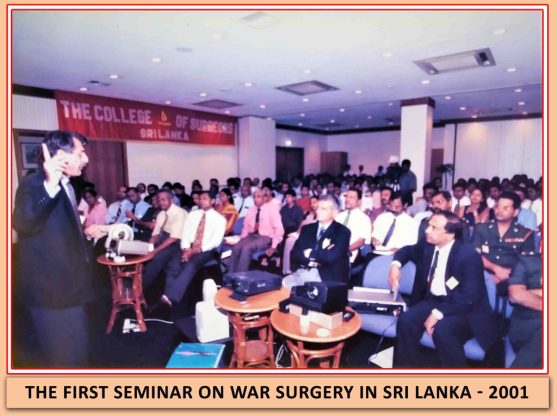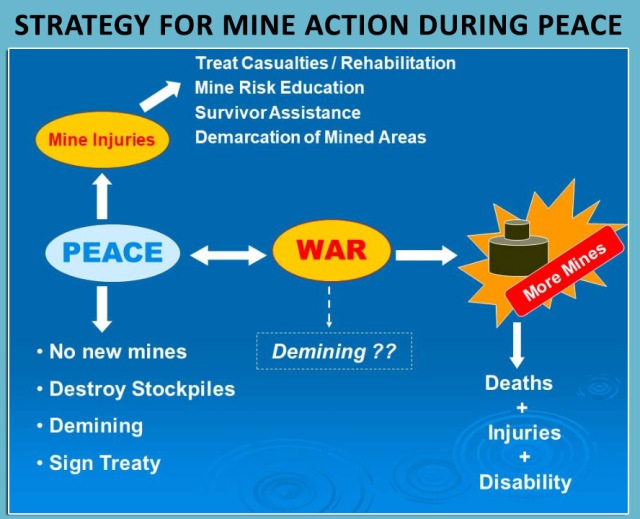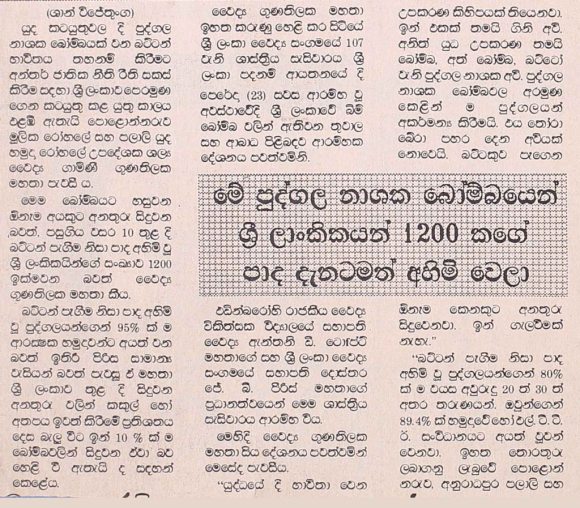Antipersonnel Mines in Sri Lanka

Learning More about Mine Injuries, Mine Action During Peace, Global Minefields and Mine Ban Treaty
A landmine is a perfect soldier: ever courageous, never sleeps, never misses
Paul Jefferson – one of the earliest humanitarian de-miners
The simplicity and cost effectiveness of mines are a major reason for the widespread use of mines in many countries that are now faced with a gruelling battle for their elimination.
Long after guns have fallen silent and peace has been declared, landmines continue to claim an estimated 15- 20,000 new victims each year globally. Mines do not distinguish between the foot-fall of a soldier from that of a child and could go on killing or injuring the children or even grandchildren of those who laid them. Only in 1988 that mines drew worldwide attention with the large number of limbless victims of mines in Afghanistan and Cambodia. Today mines are injuring and killing civilians in over sixty-six countries.
In a post-conflict situation, eighty percent (80%) of the mine victims are civilians, with less than ten percent (10%) of them having access to medical care and rehabilitation. Landmines pose a great danger to farming communities, cause environmental destruction and hinder economic growth. For a country engaged-in, or recovering from war, the presence of thousands of people disabled by mines is a heavy economic and social burden for the family and the community. For the victims, it is unending tragedy.
Detection and removal of antipersonnel mines is at the present time a serious problem of political, economical and humanitarian dimensions globally.
- An estimated 110 million landmines is in the ground now, and an equal amount waiting to be planted or destroyed
- The cost of producing a mine is 3 – 30 USD
- The cost of removing a mine is 300 – 1000 USD
- Mines and explosive remnants of war result in casualties in every region of the world causing an estimated 15 – 20,000 injuries each year.
- The most common injury is the loss of one or more limbs
- There are eleven mine producing countries.
- The most affected countries are Egypt, Angola, Afhganistan, Iraq, China, Cambodia, Mozambique, Croatia, Bosnia, Somalia, Sri Lanka ……………. (Landmine Monitor)
Learning More about Mine Injuries
Antipersonnel (AP) mines were unheard of in Sri Lanka until the North- East conflict between the Government Forces and the Liberation Tigers of Tamil Ealam (LTTE). During this conflict which lasted from 1983 – 2009, both parties to the conflict used antipersonnel mines with the LTTE using their own improvised mines. I had the opportunity to treat many victims of AP mines in hospitals in the war front and areas bordering the war front. The majority of victims that I treated were from the armed forces, but occasionally there were civilians as well.

The majority of these victims had amputations of their injured limbs as described in the previous post. These victims needed rehabilitation and the Government obtained the help of Israeli Surgeons who had many years of treating war victims. They sent a team of surgeons and experts for fitting artificial limbs.
Israel Offers Surgical Training and Artificial Limbs for Amputees
In view of my interest in this field I was offered a scholarship to Israel, to the Sackler Faculty of Medicine in Tel Aviv. I spent three months there learning the correct technique of amputation and also the manufacture and fitting of artificial limbs. In fact some soldiers injured in battle were sent to Israel for their limb-fitting. However this process could not go on for long as the Israeli prosthesis were far too expensive for us. But the knowledge that I received in Israel was beneficial in managing our casualties in Sri Lanka. My interest in that field grew more.


Sri Lanka Medical Association Oration – 1994, lectures and publications
I collected the data on the management of antipersonnel mine injuries managed from various hospitals. These were presented to the Sri Lanka Medical Association (SLMA). I was invited to deliver the prestigious SLMA Oration in 1994.
In this oration I discussed the management of 191 victims of AP mines, comparing these with those treated in hospitals in Cambodia, Thailand, Somalia, Afhganistan and hospital run by the International Committee of the Red Cross (ICRC). I also highlighted the socio-economic issues faced by people living in countries affected by mines especially the large number of amputees in countries like Cambodia and Angola. The need to avoid a similar post-conflict situation as in Sri Lanka was emphasised as both parties to the conflict were using a large number of AP mines.

References
- Injuries due to antipersonnel landmines in Sri Lanka. Ceylon Medical Journal 1995. 40,141 – 145. Gamini Goonetilleke (original article)
- The scourge of antipersonnel landmines – leading article. The Sri lanka Journal of Surgery 1997. 15 , 1-3 Gamini Goonetilleke
As this was a new problem caused by the raging conflict in the North-East of the country, I was invited to deliver lectures on injuries caused by antipersonnel mines at meetings of medical associations throughout the country. It was also a topic of discussion at the first Joint meeting of The College of Surgeons of Sri Lanka with The Royal College of Surgeons of England held in Sri Lanka in 1995 and also at many International meetings.
Seminars with the International Committee of the Red Cross (ICRC)
The International Committee of the Red Cross had wide experience in managing war casualties in view of the fact that their teams had been working and managing casualties in many war torn countries. They had also published several books giving guidelines and protocol in managing war injuries and mine injuries. They had a office in Sri Lanka although not involved in casualty care but helping in other aspects in war zones. The College of Surgeons of Sri Lanka together with the Sri Lanka Medical Services and the ICRC organised a series of symposia to discuss the management or war casualties. The resource persons were from all three teams. This added a further dimension to improve our knowledge.

Post Conflict Problems, Prevention of Mine Injury and Deaths of Civilians
Long after guns have fallen silent and peace has been declared, landmines continue to kill and injure people. This is a dangerous situation for people returning to their homes after the conflict. An examination of the devastating medical, social and psychological effects of mines experienced by a population in living in other war torn countries reveals that many a civilian has been killed or maimed for life by antipersonnel mines. The numbers of people maimed in other countries clearly reveal the danger of mines after conflict. Cambodia with a population of 8 million people and a war that went on for 12 years has 36,000 amputees. Angola, Iraq, Egypt, Somalia and other war torn have similar problems.
In Sri Lanka the conflict ended in 2009. Over the last ten years every attempt has been made in accordance with UNDP guide lines and with the support of the Sri Lanka Army and other humanitarian agencies funded by foreign governments to rid the country of mines and unexploded ordnances (UXO). The densely mined areas have been in Jaffna, Kilinochchi and Mullativu in the North of the country. Sprawling over 12 Sq. Km, the minefield in Muhamalai in the Northern District of Kilinochchi has been described as the most densely mined area in the world. This has been a region of bitter fighting between the Sri Lanka Army and the LTTE as it is borders Elephant Pass which is the entry point to Jaffna peninsula.

There have been a few incidents of death and injury affecting people coming back to their homes. The number of deaths of civilians has been reported as 22 in 2013, 16 in 2014 and 06 in 2015 respectively. Six Hundred thousand mines had been removed by 2016 (more recent figures are not available). Mines have also prevented 300,000 people being resettled in their homes and also going ahead with their livelihood in agriculture and fishing.

SRI LANKA’S LAND MINE LEGACY
An estimated 1.6 million mines to be cleared after the end of the war in May 2009 Area contaminated with mines estimated at 552 Sq Km (National Strategy for Mine Action in Sri Lanka)

SRI LANKA SIGNED THE OTTAWA TREATY TO LANDMINES IN 1987 AND BECAME THE 163RD COUNTRY TO BECOME A STATE PARTY TO THE OTTAWA CONVENTION TO PROHIBIT THE USE, STOCKPILING, PRODUCTION AND TRANSFER OF ANTIPERSONNEL MINES.


















Dear Reader, you might like the next story which is titled : ‘THE FIRST SEMINAR ON WAR SURGERY IN SRI LANKA’
